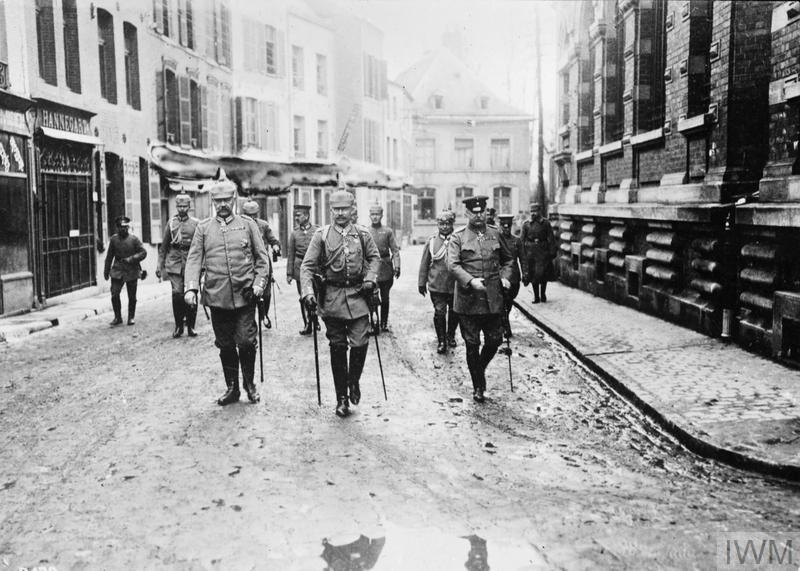Centenary News considers how years of deadlock came to an end in 1918, as first the Germans and then the Allies went on the attack.
Hopes for an end to the First World War in 1918 would have appeared remote as the year dawned. Indeed, it was widely assumed that the fighting would last into 1919.
Deadlock continued on the Western Front, with the armies of Britain, France, their allies and Germany still locked in a struggle for the crucial breakthrough.
But Field Marshal Sir Douglas Haig’s warning of ‘Backs to the Wall’ in April, followed by General Erich Ludendorff’s verdict on the German army’s ‘Black Day’ at Amiens in August, are reminders of just how rapidly fortunes shifted in 1918.
July would prove to be the pivotal month. For those of us who aren’t military historians, how this point was reached, and what happened next can seem mystifying.
However, even during the first days of January, there were portents of change and shifts in the established order.
US President Woodrow Wilson used a speech to Congress to set out his Fourteen Points, a statement of principles for winning the peace once the Great War was over.
Russia’s new revolutionary socialist leaders – the Bolsheviks – were in talks with the Central Powers to end the war on the Eastern Front, with consequences for operations in the west.
America, having joined the Allied side in 1917, was still building up its army for deployment on the battlefields of Europe.
Germany’s military chief, General Ludendorff, gambled on a series of offensives to achieve victory while he still had the upper hand before large numbers of US troops arrived.

Kaiser Wilhelm II, Field Marshal Paul von Hindenburg and Erich Ludendorff in a town on the Western Front, June 1918 (Photo © IWM Q 23964)
Soldiers and equipment were moved en masse from eastern Europe to reinforce the German armies in France and Flanders.
The Treaty of Brest-Litovsk, signed on 3 March 1918, forced the Bolsheviks to give up the richest western areas of the former Tsarist empire in return for peace.
Less than three weeks later, on March 21, Ludendorff unleashed Operation Michael, the first part of Germany’s Spring Offensive, striking at the British and French on the Somme.
Over the next four months, a series of blows was aimed at the western allies in Picardy, in Flanders, on the Aisne and in Champagne.
And a hidden enemy would emerge, in the form of a deadly influenza outbreak, known as Spanish Flu, that would develop into a global pandemic.
The Spring Offensive – and ‘Backs to the Wall’
Such was Operation Michael’s impact that Britain and France agreed to a introduce a unified military command for the first time, with General Ferdinand Foch put in charge of coordinating operations.
In April, as the Germans threatened Flanders, General Sir Douglas Haig issued one of his best known orders of the Great War – with their ‘backs to the wall’ British forces were instructed to fight to the last.
The British and French lines buckled and bowed. In response to urgent pleas, hundreds of thousands of American soldiers began pouring into Europe as the Germans advanced to within striking distance of Paris. The United States Marine Corps made its first appearance in battles to defend the Marne at Château-Thierry.
But despite the advances, Ludendorff’s armies failed to achieve the strategic breakthrough they needed for victory. Casualties were high, communications were stretched, and morale started to sag. There are numerous accounts of German soldiers marvelling at the rations they found in the Allied lines.
The naval blockade of Germany, imposed at the start of the war, had taken its toll on supplies, in the field and on the home front.
From mid-July, the initiative passed to the Allies. As in 1914, German troops were held on the River Marne and then forced to pull back, in what is known as the Second Battle of the Marne. German plans for another offensive were dropped.

Ferdinand Foch, appointed supreme commander in March, rallied Allied forces with his cry of ‘Tout le monde à la bataille’ – everyone into battle. This statue is in Lille (Photo Centenary News)
The ‘Black Day of the German Army’ – and the Hundred Days to Allied victory
On August 8, British-led forces attacked at Amiens, advancing eight miles in a matter of hours Notable successes were achieved by the Australians and Canadians. Ludendorff himself described it as ‘The Black Day of the German Army in the history of the war.’
The German forces here were not the strongest, and their positions poorly defended. But crucially, Allied operational and technical advances now came into play.
Artillery fire could be targeted accurately without alerting the enemy, advancing troops were better protected by ‘creeping barrages’, there was an emphasis on coordinated attacks, and no longer would armies be ordered to keep battering away at defensive strong points.
It wasn’t all straightforward, but in August and September, German troops fell back to the Hindenburg Line, their formidable system of defences in Northern France, barring the way to Belgium and Germany itself.
Multiple attacks in late September succeeded in breaching even this barrier.
It was now that the alliance between the Central Powers started to fall apart under Allied pressure, and German thoughts turned towards trying to salvage a favourable peace.
Bulgaria was the first to agree an Armistice, forced out of the war by an offensive on the Macedonian Front.
Turkey was defeated at the Battle of Megiddo in Northern Palestine, clearing the way for the capture of Damascus by the Allies. On October 30, it too agreed an armistice.

20,000 Italian, Austrian, Czech and Hungarian soldiers of the Great War, known and unknown, rest at Casteldante Monumental Shrine in Rovereto, Italy (Photo: Centenary News)
The Austro-Hungarian Empire, having failed in a new Italian offensive in June, started to disintegrate as its subject peoples seized the chance to form their own independent states in eastern and central Europe, and in the Balkans.
The end came following a rout by Italian forces at the Battle of Vittorio Veneto in late October/November. Austria-Hungary also sought an armistice, leaving Germany isolated.
Against the odds, there was a last gasp of German resistance. But Kaiser Wilhelm had lost the support of his troops (sailors mutinied in Kiel as revolutionary unrest spread), and abdicated, leaving a new leadership to make peace.
The Armistice, on tough terms dictated by the Allies, came into effect at 11 o’clock in the morning on November 11.
What had started with an assassination in Sarajevo in 1914 ended with signatures on a document in a train carriage brought to a French forest. In the intervening years, millions had been killed or maimed for life, and the stage was now set for redrawing the maps of Europe and the Middle East, with fateful consequences for the future.

Two graves at CWGC St Symphorien Cemetery, Mons, spanning the start and finish of the First World War – from the first Western Front clash between the British and German armies in August 1914 to the last days of German resistance in October 1918 (Photo: Centenary News)
See also our Centenary News summary of 1918 anniversaries (including some 2018 event programmes announced so far).
Posted by: CN Editor Peter Alhadeff
Images courtesy of Imperial War Museums, © IWM Q 23964 (Hindenburg, Kaiser Wilhelm & Ludendorff); Centenary News
